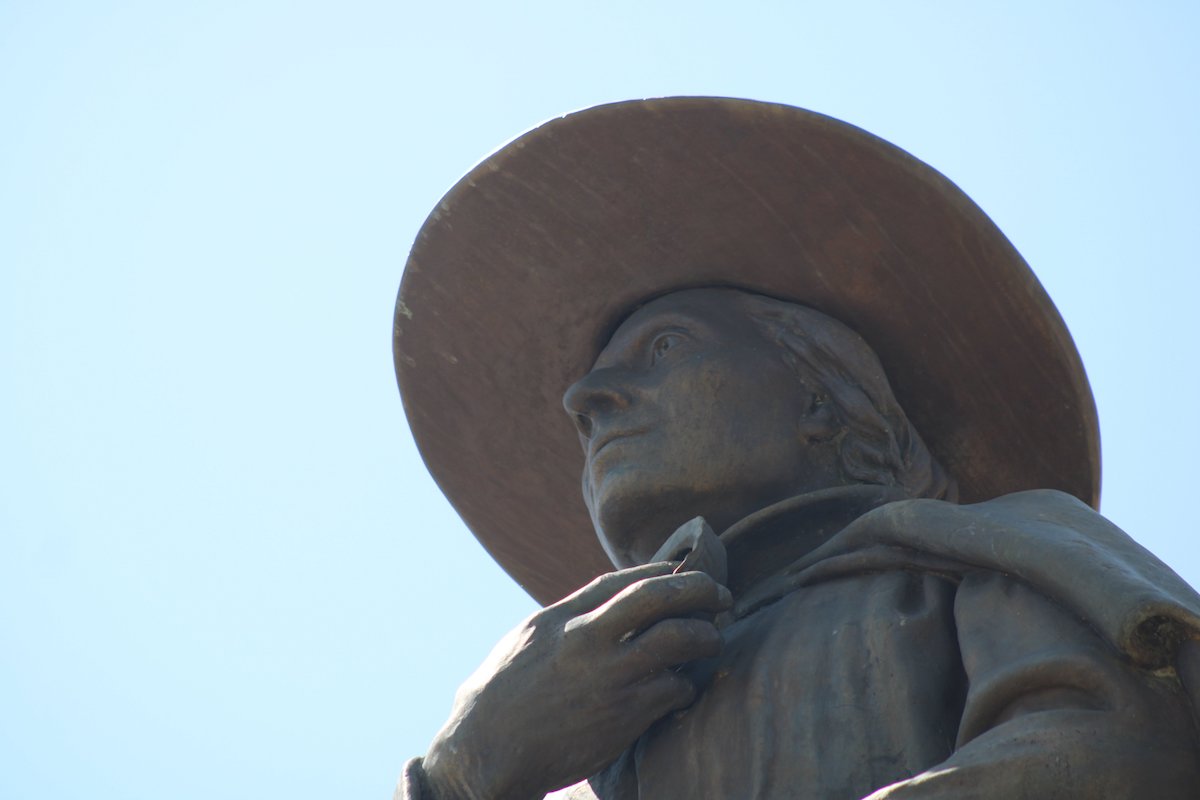
TUCSON, Ariz. — For Rafael Barceló Durazo, who grew up across the border from Arizona in the Mexican state of Sonora, Venerable Father Eusebio Kino is a symbol of unity.
Today, as the Mexican consul in Tucson, he also looks to the famed missionary known as Padre Kino — and declared venerable by Pope Francis — as an example to follow.
“I have always admired the courage Padre Kino required among the missionaries that came to a distant and inhospitable land and climate like Sonora and Arizona,” Barceló told CNS. “But he didn’t only come to transmit his message of faith. He also came with a great Christian love in the way he viewed the world and related with the indigenous communities of the Pimería Alta and Pimería Baja.”
Barceló was one among those attending the “Three Statues for Three Nations” ceremony and Mass honoring the Italian-born priest Aug. 8.
Held in front of the “Padre on Horseback” statue on the street bearing his name, the ceremony recognized the 30th anniversary of the city of Tucson presenting the same statue to the people of Segno, Italy, Padre Kino’s hometown. A third statue is in Magdalena de Kino in Sonora state in northern Mexico, where the priest died in 1711.
A similar ceremony was held in Segno the same day. The two celebrations were coordinated with videos of each event shared.
Silvia Chiave, consul general of Italy in Los Angeles, represented the missionary’s home country at the Tucson ceremony.
“I’m very grateful to the city of Tucson for inviting me and also to let me rediscover this exceptional figure of Father Kino and his legacy,” she said at the ceremony.
Chiave read a letter from Italy’s minister of foreign affairs, Luigi Di Maio, that described Father Kino as “a pioneer of intercultural and people-to-people dialogue who promoted mutual understanding and solidarity.”
“These are values that the United States and Italy both share and firmly believe in, and which must always be remembered, recognized and celebrated,” the letter said.
Born Eusebio Francesco Chini Aug. 10, 1645, in Segno, he entered the Society of Jesus and was ordained June 12, 1677. When the young priest set out for Mexico in 1678, he changed his surname to Kino. He is believed to have traveled roughly 50,000 miles and established 21 missions in what is now Arizona and Sonora.
Padre Kino also introduced European seeds, fruits, herbs and grains for the Native Americans to use, taught them more efficient irrigation methods and introduced ranching to Arizona.
Rosie Garcia, president of the Kino Heritage Society, said she hopes the event serves to spread Padre Kino’s sainthood cause throughout Arizona and the nation.
“It was really great to see the state, the county and the city present proclamations to us because that means that they see Father Kino as a very important spiritual and historical figure,” Garcia said.
The ceremony also recognized Padre Kino’s Aug. 10 birthday and that a year had passed since Pope Francis elevated his cause for canonization by declaring him venerable July 11, 2020.
Retired Bishop Gerald F. Kicanas of Tucson said Padre Kino is worthy of sainthood because of the way he cared for others.
“He was willing to leave Segno in Italy to come all the way here to Pimería Alta, northern Mexico and southern Arizona,” Bishop Kicanas said. “Sometimes I wonder as I drive around the Diocese of Tucson, I can’t imagine how Father Kino did it in those days. That’s a miracle.”
At a Mass following the ceremony at nearby St. Augustine Cathedral, Jesuit Father Greg Adolf said in his homily that Padre Kino invited people to experience a “new way of being human in a transfixed and transformed humanity.”
When visiting a new village, Padre Kino would clear an area and draw a map of the world on the ground with a stick while showing people where they lived in relation to where he came from and where Jesus ministered, Father Adolf said.
“He stretched their horizons,” he said. “The excitement of meeting new people, of connecting with new tribes and hearing their wisdom, experiencing what they know in their own long experience as desert peoples created a mutuality and a great respect.”
Jesuit Father Chris Corbally, liaison between the Kino Heritage Society and the Jesuits in the U.S., celebrated the Mass. As an astronomer at the Vatican Advanced Technology Telescope outside of Tucson, he looks to Padre Kino as a source of inspiration.
“He’s a pioneer, an explorer, and so every astronomer has to be an explorer and a pioneer in particular ways,” Father Corbally said.
Alex Jacome helped raise $90,000 for the three statues when he was involved with the Arizona Historical Society. Nearby mines donated copper for making the brass used in the statues.
“The idea is that if we make one, what if we make more than one? We could make one for where he lived, where he died and where he was born,” Jacome said.
Gwen Powell, an Episcopalian from Tucson who attended the ceremony said she first learned of Padre Kino when she moved to Arizona and saw several places named for him. His March 15 death is recognized on the calendar of the Episcopal Diocese of Arizona.
“That statue, it’s very evocative of humility, service, all the things that he is,” she said.
“Father Kino should remind us of our humanity and our goal to serve the Lord. For me, it’s not a Catholic thing, it’s a spiritual thing.”






